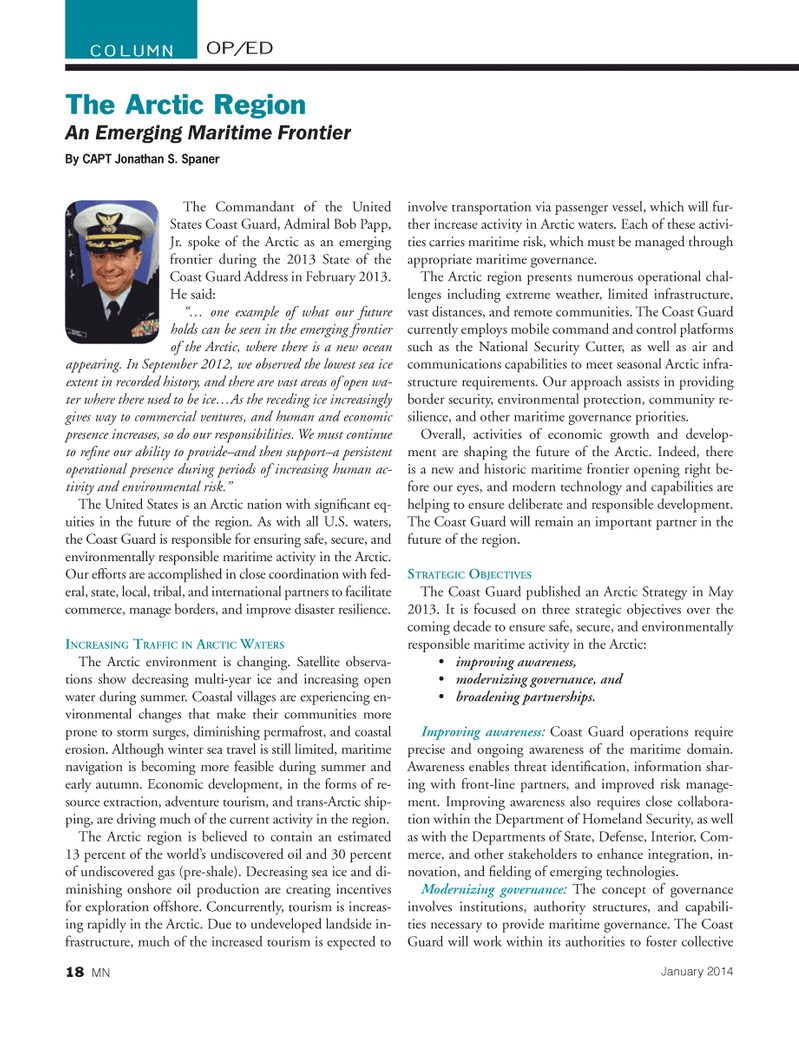
Page 18: of Marine News Magazine (January 2014)
Tug Boat Technology
Read this page in Pdf, Flash or Html5 edition of January 2014 Marine News Magazine
The Commandant of the United
States Coast Guard, Admiral Bob Papp,
Jr. spoke of the Arctic as an emerging frontier during the 2013 State of the
Coast Guard Address in February 2013.
He said: “… one example of what our future holds can be seen in the emerging frontier of the Arctic, where there is a new ocean appearing. In September 2012, we observed the lowest sea ice extent in recorded history, and there are vast areas of open wa- ter where there used to be ice…As the receding ice increasingly gives way to commercial ventures, and human and economic presence increases, so do our responsibilities. We must continue to refi ne our ability to provide–and then support–a persistent operational presence during periods of increasing human ac- tivity and environmental risk.”
The United States is an Arctic nation with signifi cant eq- uities in the future of the region. As with all U.S. waters, the Coast Guard is responsible for ensuring safe, secure, and environmentally responsible maritime activity in the Arctic.
Our efforts are accomplished in close coordination with fed- eral, state, local, tribal, and international partners to facilitate commerce, manage borders, and improve disaster resilience.
INCREASING TRAFFIC IN ARCTIC WATERS
The Arctic environment is changing. Satellite observa- tions show decreasing multi-year ice and increasing open water during summer. Coastal villages are experiencing en- vironmental changes that make their communities more prone to storm surges, diminishing permafrost, and coastal erosion. Although winter sea travel is still limited, maritime navigation is becoming more feasible during summer and early autumn. Economic development, in the forms of re- source extraction, adventure tourism, and trans-Arctic ship- ping, are driving much of the current activity in the region.
The Arctic region is believed to contain an estimated 13 percent of the world’s undiscovered oil and 30 percent of undiscovered gas (pre-shale). Decreasing sea ice and di- minishing onshore oil production are creating incentives for exploration offshore. Concurrently, tourism is increas- ing rapidly in the Arctic. Due to undeveloped landside in- frastructure, much of the increased tourism is expected to involve transportation via passenger vessel, which will fur- ther increase activity in Arctic waters. Each of these activi- ties carries maritime risk, which must be managed through appropriate maritime governance.
The Arctic region presents numerous operational chal- lenges including extreme weather, limited infrastructure, vast distances, and remote communities. The Coast Guard currently employs mobile command and control platforms such as the National Security Cutter, as well as air and communications capabilities to meet seasonal Arctic infra- structure requirements. Our approach assists in providing border security, environmental protection, community re- silience, and other maritime governance priorities.
Overall, activities of economic growth and develop- ment are shaping the future of the Arctic. Indeed, there is a new and historic maritime frontier opening right be- fore our eyes, and modern technology and capabilities are helping to ensure deliberate and responsible development.
The Coast Guard will remain an important partner in the future of the region.
STRATEGIC OBJECTIVES
The Coast Guard published an Arctic Strategy in May 2013. It is focused on three strategic objectives over the coming decade to ensure safe, secure, and environmentally responsible maritime activity in the Arctic: improving awareness, modernizing governance, and broadening partnerships.
Improving awareness: Coast Guard operations require precise and ongoing awareness of the maritime domain.
Awareness enables threat identifi cation, information shar- ing with front-line partners, and improved risk manage- ment. Improving awareness also requires close collabora- tion within the Department of Homeland Security, as well as with the Departments of State, Defense, Interior, Com- merce, and other stakeholders to enhance integration, in- novation, and fi elding of emerging technologies.
Modernizing governance: The concept of governance involves institutions, authority structures, and capabili- ties necessary to provide maritime governance. The Coast
Guard will work within its authorities to foster collective
The Arctic Region
An Emerging Maritime Frontier
By CAPT Jonathan S. Spaner
OP/ED
COLUMN 18 MN
January 2014
MN JAN14 Layout 18-31.indd 18 12/20/2013 10:04:37 AM

 17
17

 19
19
